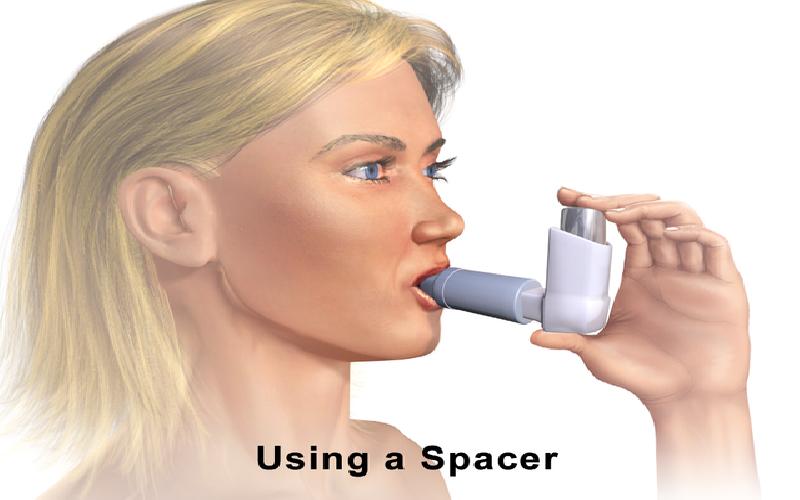For chronic asthma, inhalers are usually the mainstay of its long term treatment. Since asthma is a disease that requires the patient to actively contribute to the overall effective management while carrying on with the day to day life, it helps to be aware about inhalers, even when the decision to use one is best left to the physician.
For a person who suffers from asthma, inhalers are like part of your accessories, something that you need to be as familiar with as your food and clothing. Hence, even though you would be using the inhaler suggested by your physician, it
is important that you understand the types of asthma inhalers and their inherent pros and cons.Asthma & the Role of Inhalers
Asthma results from shrinking of space in the small airways within lung, resulting from inflammation, secretion of excess quantity of mucus and muscular spasm of muscles of the bronchioles. It is largely a result of hyper-reactivity of these airways to any kind of dust particles or other irritations like changes in temperature. In a patient of asthma, this causes difficulty in breathing and cough.
Asthma can be of varying severity, ranging from occasional and mild to sustained and severe. The asthma inhalers help by preventing or reversing the airway blockage primarily by relaxing the smooth muscles of the bronchioles. They deliver the medication directly to the airways, where it is required. By doing so, their effect is fast and the medication need not go through the whole body to reach lungs.
Types of Asthma Inhaler Devices
Inhalers are the devices that deliver a dose of medication that is inhaled into the lungs and airways. There are four major types of inhalers.
(i) Pressurised M.D.I.s (Metered Dose Inhalers) - These deliver a fix dose to the mouth when pressed, which has to be then inhaled. Their major advantages are that they are simple to operate, small, cheap and easy to handle or carry. However, their use is optimised only when the pressing of its top for delivery is fully coordinated with the inhalation process. If this coordination is faulty, the full dose will not reach the airways. So, it may not be ideal for younger children or very debilitated patients.
(ii) Breath-Activated M.D.I.s (Auto-inhalers) - These are slightly bigger in size. They do not require pressing of top of inhaler. Breathing triggers the delivery of medicine, and so it results in better coordination between delivery of medicine and inhalation.
(iii) Inhalers with Spacer Devices - These inhalers have a spacer or reservoir in between the canister and the mouth, so that when the inhaler is pressed, it releases the medicines in the spacer, from where it is sucked in during the process of inhalation. It also results in better coordination, but is larger and hence less convenient to carry. But this may be the best inhaler for small children or very weak patients.
(iv) Dry Powder Inhalers - These involve a dose of dry medicine being sucked in when we breathe, but requires greater effort to suck the medicine in. They come in many designs and sizes, and can be used by most people except children and very sick patients.
Types of Asthma Inhaler Medication
The medication used in asthma inhalers can be similarly divided into four major categories.
(i) Inhaler for Immediate Relief - These consist of short acting bronchodilators like albuterol (Proventil, Ventolin) and pirbuterol (Maxair). They provide immediate relief by causing dilatation or opening up of smaller airways in the lung. These are actually beta-2 agonists which relax the smooth muscles surrounding the bronchioles (smaller airways). Typically their action is short-lived. They provide immediate relief, but their effect is not prolonged.
(ii) Long Acting Beta-2 Agonists (L.A.B.A.) - These also act by relieving the bronchospasm caused by the smooth muscles around the bronchioles, but they take much longer to provide relief and their effect is more persistent. They include salmeterol (Serevent) and formoterol (Foradil). Whenever so required they are taken for a longer duration, and are usually taken along with steroids, to improve their efficacy. The combination of LABA and steroids are the most common prescription for chronic asthma that requires persistent or long term treatment on a regular basis.
(iii) Steroids - Steroids prevent inflammation within the airways, and so reduce the swelling and blockage of the airways. In this open, they also open the airways and provide relief. Usually, they take some time to reach their full effect. They are usually taken for a longer durations, in patients who require regular medication. Steroids used as inhalation include fluticasone (Flovent), beclomethasone dipropionate (Qvar), budesonide (Pulmicort) and flunisolide (Aerobid).
(iv) Mast Cell Stabilizers - They include Cromolyn and nedocromil. These are medications which act in a long term by reducing the hypersensitivity of the bronchial mucosa, and prevent the development of asthma attacks in the long run. They are usually taken as a regular treatment. They are most effective when taken along with a steroid.
Choice of Asthma Inhaler
You need to choose the medication as well as the inhaler device.
For occasional use, the best asthma inhaler is a Pressurised metered dose inhaler with short acting bronchodilators like albuterol (Proventil, Ventolin) and pirbuterol (Maxair). They are easy to use, can be kept and carried for longer periods, conveniently taken along in case of travel and the best option for infrequent use.
For those requiring regular asthma medication on a long term basis, it has to be a combination of steroids with long acting beta-2 agonists . For those who are able to coordinate their inhalation with delivery of medication, Pressurised M.D.I. s are still the preferred choice. However, the dry powder inhaler also offer an equally effective choice.
For those requiring regular medication, and not capable of ensuring optimum coordination between inhalation and drug delivery, breathing induced M.D.I.s and inhalers with spacers are preferable. For such patients, it is important that the necessary dose reaches the destination on a regular basis. The choice of medication will usually be long acting beta 2 agonists in combination with steroids.
Some patients of asthma respond very well to a regular dose of mast cell stabilizers, with or without steroids. In their case too, pressurised M.D.I.s are the preferred device.
Usually a person with asthma would normally like to go by the advice of the physician. However, given the prolonged course of disease, and frequent exacerbations that are a part of it, there may be times when one may need to make choice. Having an idea about the different asthma inhalers and the medication they contain will be helpful and reassuring.










